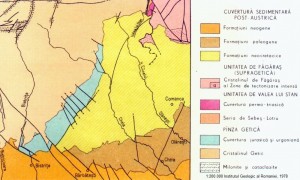Geology
Tectonics

From the tectonics point of view, the area of the Buila-V├ónturari┼úa National Park is part of the Carpathian Orogenesis. The Buila-V├ónturari┼úa Massif is part of the Getic Knapp, which is a unit of the Middle Dacides of the Middle Carpathians, set down during the Senonian period, within the Laramic tectogenesis. The Getic Knapp is composed of pre-alpine cristalophyle formations and sedimentary layers where the oldest sediments are aged in the Upper Carboniferous. Due to erosion, the sediments in the Getic Knapp are only present in a few areas around the country, the most important are: Bra┼čov-D├ómbovicioara, Buila-V├ónturari┼úa, Ha┼úeg and Re┼či┼úa-Moldova Nou─â. These sediments have passed through tectogenetic processes in two phases. The first significant unconformity is pre Albian, when the Getic drifting began and it is related to the first Getic phase, the age of the first mounting being placed after the Lower Aptian and before the Upper Aptian ended. The second Getic phase, meaning the main Laramic drifting, occurred in the Senonian period, when the Getic Knappe, with the Severin Layer as its basis, covered the Danubian field.
|
|
 |
|
Stratigraphy In the Buila-Vânturariţa Massif area there have been subsequent deposits of metamorphic and sedimentary layers that can be seen entirely on the openings formed by the four rivers that cross through the limestone formation, each carving a sector of gorges.
Crystalline formations In the Buila-V├ónturari┼úa Massif, the metamorphic rocks can be seen at surface on the Northwestern sides, on the valleys of the Bistri┼úa, Coste┼čti, Cheia and Ol─âne┼čti rivers, and on the skyline area, where the deposits of eroded sediments (Curm─âtura Builei) come out to the surface. The metamorphic evolution of the gneissic units in the Getic Knappe occurred during the Varisc cycle (300 - 350 million years ago). The evolution of metamorphytes in the Middle Carpathians now have clearer clues, that underline its multiple stages character and a different evolution of the units, Getic-Overgetic versus Danubian, in a succession of events from subduction to mountain formation and a tectonic inversion in the Middle and Upper Cretaceous. Metamorphic rocks in the Getic-Overgetic field can be divided in two main categories: a dominant type of crystalline limestones, amphibolites, mica schists, paragneisses, quartzes, where the migmatites are missing, representing the metalithofacies of Negoi. The second is rather poor in carbonate and amphibolite rocks, being dominated by gneisses and migmatites, representing the metalofacies of Sebe┼č-Lotru, where the crystalline formations of the Buila-V├ónturari┼úa massif are comprised.


Sedimentary formations After the ending of the Baikal cycle, that generated epimetamorphical schists, the Getic sector evolved as an emerged area undergoing the denudation process. It became an area of accumulation in the neo-Carboniferous, when the mostly continental deposits were accumulated. In the Alpine cycle, the sedimentation process began after the exposition process that went on during the Triassic. In the Jurassic, several valleys got formed, Buila-Vânturariţa among those. The Getic sector gets exposed again after the middle-cretacian tectogenesis. After that, a transgression took place in the Cenomanian period, but sedimentary formations were mostly eroded.
In the Buila-Vânturariţa Massive area, the sedimentary succession is formed of deposits from the Upper Jurassic and Lower Cretaceous:
Lower Bajocian-Barhonian: massive sandstones and massive, spatic and coral limestones.
Upper Bathonian ÔÇô Lower Callovian: calcareous sandstones and limonitic limestones with green and red spots and with mica schist elements.
Middle-upper Callovian: schist sandstones, calcareous, yellow-red, microconglomerates and yellow mica limestones.
Oxfordian: malmy schists, malmy limestones, red limestones and red limestones with jasps.
Lower Kimmeridgian:: red fine limestones, stratified
Upper Kimmeridgian ÔÇô Tithonian: 250-300 m of reef massive limestones.
Upper Tithonian ÔÇô Berriasian: missing.
Valanginian: oosparites, pelsparites, intrapelsparites, which pass laterally and subsequently to biomicrites.
Hauterivian: missing.
Baremian-Aptian: Urgonian facies that settles transgressively and unconformly over the Neoconian formations.
The Cretaceous formations represent a detritic series very well developed (10000 m maximum, the width going up from south-west to north-east):
Lower Albian-Vraconian: the lower layer of sandstones and conglomerates
Vraconian-Turonian-Coniacian: the lower malms-clay stones layer where marnas alternate with clay stones, and sometimes with thin sandstones.
Santonian ÔÇô Lower Campanian: the superior layer of gresii and conglomerates
Uper Campanian ÔÇô Maastrichtian: upper malmy-clay stones layer.


